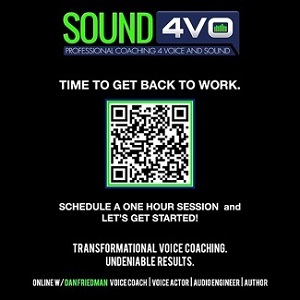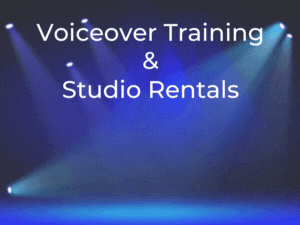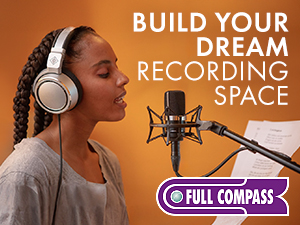|
Home Studio 'Monitor' Speakers:
What To Know Before You Buy
By David Goldberg
Owner & Director, Edge Studio
 In your voice over home studio, "monitor" speakers and/or headphones are important for accurately reproducing what you've recorded. This article focuses on speakers. In your voice over home studio, "monitor" speakers and/or headphones are important for accurately reproducing what you've recorded. This article focuses on speakers. A pair of speakers will cost more than comparable headphones, but there are situations where speakers are preferable or necessary.
Every speaker has a different character, even within this category:
WHAT TO KNOW
Whether you select speakers by listening to them or by following authoritative reviews, you want to be able to trust the sound your speakers produce.
Here's what you should know about speakers, including:
1. Accurate bass and treble frequencies
2. Low distortion
3. Original sound
4. Active or passive
5. Subwoofer
6. Getting what you pay for
7. Tech notes
1. ACCURATE BASS & TREBLE
As with headphones, speaker frequency response should be "flat" - neither emphasizing high and low frequencies, nor letting them drop off.
It is relatively easy for a speaker to reproduce the midrange tones that predominate in the human voice. Most speakers do this.
But high and low frequencies are still important. Luckily, high frequencies are also relatively easy to faithfully produce, andmost speakers do an adequate-to-good job at this.
It is these overtones that help make your voice distinctive, and are featured in "S" sounds (sibilance) and other natural sounds.
BIGGER FOR BASS
But bass is much harder for a relatively small speaker to produce accurately.
If your speakers don't adequately reproduce bass frequencies, you won't notice rumble, popping, and certain background noise in your recordings.
Unfortunately, most of your clients will.
ADDING MUSIC OR SFX?
Frequencies become even more important if you're adding music and sound effects, or equalizing the sound (adjusting the frequency curve).
Most voice over performers don't need to do this for their clients, but it's something to consider.
All in all, you need to hear any bad sounds that might creep into your recording, such as hiss, subway rumble, and so on.
Although good headphones can help you check this, your speakers should be capable of it, too.
2. LOW DISTORTION
Judging distortion requires a knowledgeable ear (and at the extreme, an oscilloscope), but you can hear it well enough for your purposes.
Do "S"s sound like "SH"s? Do "F"s sound a bit digital? That's distortion.
It might be in the recording. But it might be the speaker.
HIGH VOLUME
Does the sound break up at high volume?
For example, the opening of Also Sprach Zarathustra (the 2001 theme) is particularly challenging.
If you try this, please begin at low volume!
Better speakers, at sensible volume, are better able to deal with this.
SOUND ODD?
Do instruments simply not sound like the real things? That's also a sign of distortion.
Check the specification sheets. At a given sound level, over a flat frequency range, a lower distortion percentage is better.
3. ORIGINAL SOUND
They shouldn't sound "too good."
As much as possible, speakers should sound like the original sound source, without "coloring" the sound and artificially enhancing it.
This advice might seem odd. But you must be aware of how your finished product will sound on the speakers used by the END listeners (as opposed to your client).
Your work may ultimately be heard on low-end computer speakers, an iPod, car radios, a boom box at the beach, a mediocre corporate sound system, etc.
BEST ISN'T GOOD
A recording that sounds excellent on high-end speakers won't necessarily sound the same when played through speakers that can't reproduce those sounds.
So if you have only one set of speakers, they shouldn't be the world's finest.
Actually, you would be wise to listen to your recordings on a wide range of speaker types. (With your demo too.)
At Edge Studio, we have excellent studio monitors. We also have a handy collection of cruddy stuff.
4. ACTIVE OR PASSIVE
You might have considered running your speakers directly from your computer or audio interface. However this is unlikely to give you sufficient volume or good fidelity.
You need an amplifier.
We suggest purchasing speakers that have an amplifier built in. These are called "active" speakers.
Usually, the amps in active speakers are designed to match them, resulting in better sound, and making them easy to set up. It also saves you the expense of using an external amplifier.
If you use an external amp (for "passive" speakers), specialized amplifiers are available. However, they tend to be relatively expensive, so using a leftover stereo receiver or an active speaker may be preferable.
Be sure its tone controls are set to flat.
5. SUBWOOFER?
Generally, the larger a speaker of comparable quality, the better it is able to reproduce the lowest frequencies.
However, size alone is not necessarily an advantage.
Another option is to choose a system that includes a subwoofer. A subwoofer is a single speaker that is dedicated to producing only the bass frequencies.
ONLY ONE SPEAKER
Because very low frequencies are not directional, only one speaker is needed to accomplish this; it mixes the bass of both stereo channels.
A subwoofer should be an integral part of a three-speaker system designed for this approach.
In any case, remember what we've discussed above, regarding frequency, distortion, etc.
6. WHAT YOU PAY FOR ...
Generally, you get what you pay for. Don't go crazy.
But remember that if you can afford a little more, the price difference will be very small when amortized over the years your speakers should serve you.
7. TECH NOTES
If the speakers will be near your computer monitor, they should be magnetically shielded to stop them from interfering with the display.
Also because speakers have powerful magnets in them, don't put your USB hard drive next to one, even if it's magnetically shielded.
Keep speakers and amps away from the computer if possible, to avoid electrical interference.
Get speakers suitable for the size of your studio. Huge speakers in a small space are not necessarily advantageous.
YOUR SPACE MATTERS
The size, shape and sound conditioning of your sound-editing workplace may also affect your choice. A pair of speakers typically has a "sweet spot" that you should be sitting in.
Learn where the manufacturer suggests you listen to speakers (for optimal sound reproduction). If your studio is not the appropriate size, find another pair of speakers.
LISTEN UP
If you already have a set of voice over-worthy headphones, consider speakers that sound similar to them (except for the spatial effect).
Sound is hard to memorize, so if you can't compare side-by-side, take notes as to what you are hearing and want to listen for:
Your ear is less sensitive to high and low tones at low volumes, so higher volume will help you judge, even though in your home studio, you may be sitting closer to them, with the volume usually fairly low.
AT 'LIKE' VOLUMES
Also compare at like volumes. Speakers played a little louder will sound misleadingly better.
If your amplifier has a "loudness" button, do not turn it on. Because turning it on artificially emphasizes the high and low frequencies. Sounds great. But it isn't accurate.
If the listening environment is noisy, ask the salesperson to close the door and quiet things down. Noise masks a multitude of sins.
UNPROCESSED SOUND
Finally, choose a recording that has "unprocessed" audio - a symphony orchestra or string quartet, rather than a contemporary pop-music mix.
Preferably, listen to a few different styles of music that use different instrumentation.
If you have an accurate recording of yourself (preferably not a highly compressed mp3 file) or some other voice, listen to that, too.
In short, choose speakers that reproduce sound cleanly and accurately, with no audible distortion, and with a wide, flat frequency response.
Also ensure that they are appropriate for your space. You'll find a variety of good options in the $200-500/pair price range.
ABOUT DAVID ...
David Goldberg is a voice-over producer, coach, and the owner of Edge Studio, a major voice-over recording studio and voice-over education company based in New York City, with additional studios in Los Angeles, Fairfield, CT and Bethesda, MD. Edge Studio offers a large variety of in-person and telecourse workshops. It also produces audio for major clients including Disney, VW, Microsoft, National Geographic, and frequently casts voice talent who have trained and produced demos there.
Email: info@edgestudio.com
Web: www.edgestudio.com/careerbuilding.htm

Your Daily Resource For Voice-Over Success
|
|
|
Tell Us What YOU Think!
Please Note: Since we check for spam, there will be a slight delay in the actual posting of your comment.
Comments (1)
BP Smyth, Narrator
11/5/2010 at 2:33 PM
Thanks ,David, for this outstanding article on speakers. Definitely one to keep on hand for reference. I for one appreciate the time you take to contribute your experience(s) to this forum.







.png)

click for new article alerts